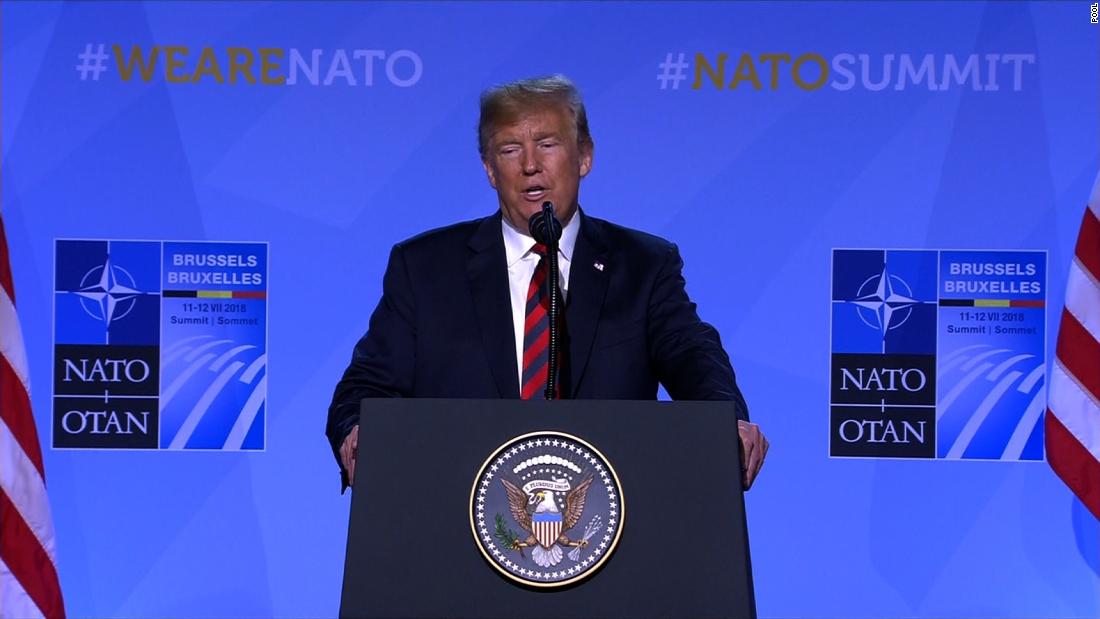Trump's NATO Stance: Ukraine's Membership Prospects

Table of Contents
Donald Trump's presidency significantly impacted NATO and its relationship with Ukraine, leaving a lasting mark on the country's prospects for membership. His unconventional approach to foreign policy and alliances introduced considerable uncertainty and raised questions about the future of the transatlantic partnership. This analysis examines Trump's skepticism towards NATO, its consequences for Ukraine's aspirations, and the shifting dynamics in the post-Trump era. We will explore the complexities of Trump's "America First" policy and its impact on the collective security architecture of the West, particularly concerning Ukraine's NATO bid.
Trump's Skepticism Towards NATO
Questioning NATO's Value and Burden-Sharing: Trump consistently criticized NATO, questioning its value and the financial contributions of its member states. His "America First" policy prioritized US national interests, often at the expense of collective action. This led to concerns about the alliance's cohesiveness and its ability to respond effectively to security challenges.
- Examples: Trump frequently pressured allies like Germany to increase their defense spending, arguing that the US was carrying an unfair burden. He questioned the continued relevance of NATO in a changing geopolitical landscape.
- Impact: This rhetoric undermined the spirit of mutual support and burden-sharing fundamental to NATO's success, straining transatlantic relations and sowing seeds of doubt among allies.
Doubt Towards Article 5 and Collective Defense: Trump's statements and actions regarding Article 5, the cornerstone of NATO's collective defense mechanism, fueled uncertainty. His reluctance to unequivocally commit to automatically invoking Article 5 in case of an attack against a member state cast doubt on the credibility of the alliance's mutual defense pledge.
- Statements: Trump's public questioning of whether the US would automatically defend a NATO ally under Article 5 undermined the alliance's deterrence capabilities.
- Implications: This had particularly worrying implications for Eastern European members, like Poland and the Baltic states, who viewed Russia as a potential threat and relied heavily on the Article 5 guarantee.
Transactional Approach to Alliances: Trump's approach to alliances was largely transactional, prioritizing bilateral deals over the established framework of collective security provided by NATO. This focus on individual agreements rather than multilateral cooperation undermined the predictability and stability of the alliance.
- Bilateral Deals: Trump favored negotiating individual agreements with countries rather than working through established NATO structures.
- Consequences: This transactional approach to alliances raised concerns about the long-term viability of NATO as a reliable security mechanism and reduced the alliance's ability to act decisively in crises.
Ukraine's NATO Membership Bid
Historical Context: Ukraine has long aspired to join NATO, viewing it as a vital step towards strengthening its security and sovereignty. However, Ukraine's path to NATO membership has been fraught with challenges, including internal political instability and, most significantly, Russia's staunch opposition.
- Historical Aspirations: Ukraine's desire to join NATO stems from a desire to integrate with the West and to secure itself against Russian aggression.
- Obstacles: Besides Russian opposition, internal political challenges and the ongoing conflict in Donbas have hindered Ukraine's progress towards meeting NATO's membership criteria.
The Impact of Trump's Presidency: Trump's presidency directly and indirectly impacted Ukraine's NATO aspirations. His skepticism towards NATO expansion, coupled with his ambiguous stance on Ukraine's territorial integrity, complicated the already challenging path to membership.
- Ambiguous Stance: Trump's reluctance to explicitly support Ukraine's NATO aspirations sent mixed signals and undermined Ukraine's efforts to secure stronger Western backing.
- Russia Relations: Trump's interactions with Russian President Vladimir Putin were also viewed with concern by many in Ukraine who feared his policies might undermine their country's security and territorial integrity.
Geopolitical Implications of Ukraine's Potential Membership: The potential inclusion of Ukraine in NATO has far-reaching geopolitical consequences. Russia has consistently opposed Ukraine's NATO membership, viewing it as a direct threat to its security interests. Therefore, Ukraine's potential accession to NATO could escalate tensions with Russia and significantly impact regional stability.
- Russian Response: Russia has repeatedly warned against NATO expansion eastward and views Ukraine's potential membership as a direct challenge to its sphere of influence.
- Regional Stability: Ukraine's NATO membership would fundamentally alter the security balance in Eastern Europe and potentially destabilize the region if not handled carefully.
Post-Trump Era: Shifting Dynamics?
Biden Administration's Approach to NATO and Ukraine: The Biden administration adopted a markedly different approach to NATO and Ukraine compared to its predecessor. President Biden has reaffirmed the US commitment to NATO and collective security, emphasizing the importance of transatlantic cooperation. This shift has been widely welcomed by Ukraine and its allies, offering renewed hope for its NATO ambitions.
- Strengthening NATO: Biden has actively worked to strengthen NATO's cohesion and its role in addressing global security challenges.
- Support for Ukraine: The Biden administration has provided significant military and financial aid to Ukraine, bolstering its defense capabilities and its overall resilience.
Current Status of Ukraine's NATO Membership Prospects: While the Biden administration's renewed support for NATO and Ukraine represents a positive shift, several challenges persist. Ongoing conflict in Eastern Ukraine, internal political reforms, and ongoing geopolitical tensions with Russia continue to complicate Ukraine's path to NATO membership.
- Ongoing Conflict: The unresolved conflict in eastern Ukraine remains a major obstacle, hindering Ukraine's progress towards meeting NATO's membership criteria.
- Reforms: Ukraine needs to continue implementing critical reforms to enhance its governance, fight corruption, and strengthen its democratic institutions to meet NATO standards.
Conclusion: The Future of Ukraine's NATO Membership in the Wake of Trump's Legacy
Trump's presidency introduced significant uncertainty regarding NATO and Ukraine's prospects for membership. His skepticism towards NATO and transactional approach to alliances cast doubt on the alliance's future and negatively impacted Ukraine’s chances of joining. While the Biden administration has attempted to repair the damage and reaffirm US support for NATO and Ukraine, several substantial obstacles remain. The future of Ukraine's NATO aspirations depends on several intertwined factors, including continued progress on reforms, resolving the conflict in the east, and navigating the complex geopolitical landscape. Further research is needed to fully understand the long-term impacts of Trump’s NATO stance and its implications for Ukraine's security. Understanding Trump's NATO stance and its effects on Ukraine's membership prospects is crucial for comprehending the evolving geopolitical landscape. Continued analysis of Trump's legacy on NATO and Ukraine's future is essential.

Featured Posts
-
 Nfl Draft 2024 Will Ahmed Hassanein Break New Ground For Egypt
Apr 26, 2025
Nfl Draft 2024 Will Ahmed Hassanein Break New Ground For Egypt
Apr 26, 2025 -
 Could Ahmed Hassanein Be The First Egyptian Ever Drafted Into The Nfl
Apr 26, 2025
Could Ahmed Hassanein Be The First Egyptian Ever Drafted Into The Nfl
Apr 26, 2025 -
 Ai Powered Blockchain Security Chainalysis Acquisition Of Alterya
Apr 26, 2025
Ai Powered Blockchain Security Chainalysis Acquisition Of Alterya
Apr 26, 2025 -
 Greenland Falsehoods A Russian Disinformation Operation Targeting Denmark And The Us
Apr 26, 2025
Greenland Falsehoods A Russian Disinformation Operation Targeting Denmark And The Us
Apr 26, 2025 -
 Stock Market Overview Dow Futures And The Implications Of Us China Trade Relations
Apr 26, 2025
Stock Market Overview Dow Futures And The Implications Of Us China Trade Relations
Apr 26, 2025
